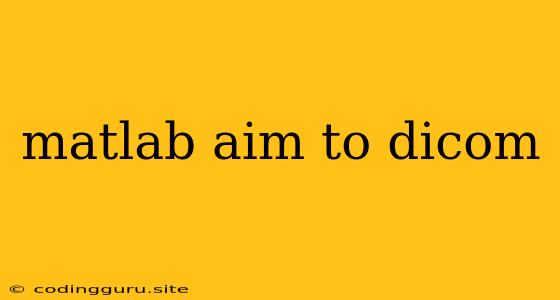Harnessing the Power of MATLAB for DICOM Image Analysis
MATLAB, a renowned numerical computing environment and programming language, proves to be an invaluable tool for handling and analyzing DICOM (Digital Imaging and Communications in Medicine) images. DICOM is a standard protocol for medical image storage and transmission, widely used in hospitals and clinics worldwide.
Why is MATLAB so well-suited for DICOM image analysis?
- Comprehensive Image Processing Toolbox: MATLAB offers a rich set of built-in functions for image processing, including image reading, writing, filtering, segmentation, and feature extraction. This makes it ideal for manipulating DICOM images.
- Efficient Data Handling: MATLAB excels at handling large datasets, which is crucial for medical imaging where images can be quite large and complex.
- Customization and Flexibility: MATLAB provides a highly customizable environment, allowing you to tailor your analysis workflows to specific needs.
- Vast Community Support: MATLAB boasts a thriving community of users and developers, making it easy to find resources, tutorials, and solutions to common problems.
How can you use MATLAB to work with DICOM images?
1. Reading and Writing DICOM Images:
MATLAB provides the dicomread function for reading DICOM files, allowing you to access the image data, metadata, and other information embedded within the DICOM file. The dicomwrite function allows you to save processed images or create new DICOM files.
Example:
% Read a DICOM image
img = dicomread('image.dcm');
% Display the image
imshow(img);
% Extract metadata
patientName = dicominfo('image.dcm').PatientName;
2. Image Preprocessing and Enhancement:
DICOM images often require preprocessing before analysis. MATLAB provides functions for:
- Contrast Enhancement: Adjust the contrast of the image using functions like
histeqoradapthisteq. - Noise Reduction: Filter noise from the image using functions like
medfilt2orwiener2. - Image Resampling: Resample the image to a different resolution using
imresize. - Geometric Corrections: Correct for distortions using functions like
imwarp.
3. Image Segmentation:
Segmentation is the process of identifying and isolating regions of interest in an image. MATLAB offers various segmentation techniques:
- Thresholding: Separate objects based on pixel intensity using
imbinarizeorgraythresh. - Region Growing: Grow a region based on similarity to a seed point.
- Active Contours (Snakes): Use deformable contours to segment objects.
- Watershed Segmentation: Partition an image into basins based on a distance transform.
4. Feature Extraction:
Once segmented, you can extract features from the regions of interest to provide quantitative insights into the medical data. MATLAB functions for feature extraction include:
- Area and Perimeter: Calculate the area and perimeter of the segmented object.
- Shape Descriptors: Extract features such as eccentricity, solidity, and aspect ratio.
- Intensity Statistics: Calculate mean, standard deviation, and other statistical measurements of the pixel intensities within the region.
5. Visualization and Analysis:
MATLAB's visualization capabilities are essential for presenting and interpreting the results of your analysis. You can use functions like:
imshow: Display the image.plot: Create graphs and charts.montage: Display multiple images in a grid.figure: Control the appearance and layout of your plots.
Example:
% Segment a region of interest
segmentedImage = bwlabel(segmentedImage);
% Calculate the area of the segmented region
area = regionprops(segmentedImage, 'Area');
% Display the segmented image and the area
imshow(segmentedImage);
title(['Area: ', num2str(area.Area)])
Conclusion:
MATLAB, with its powerful image processing capabilities, provides a comprehensive platform for analyzing DICOM images. By leveraging MATLAB's extensive functions and its flexible environment, you can gain valuable insights from medical images, contributing to improved diagnosis and treatment planning.
